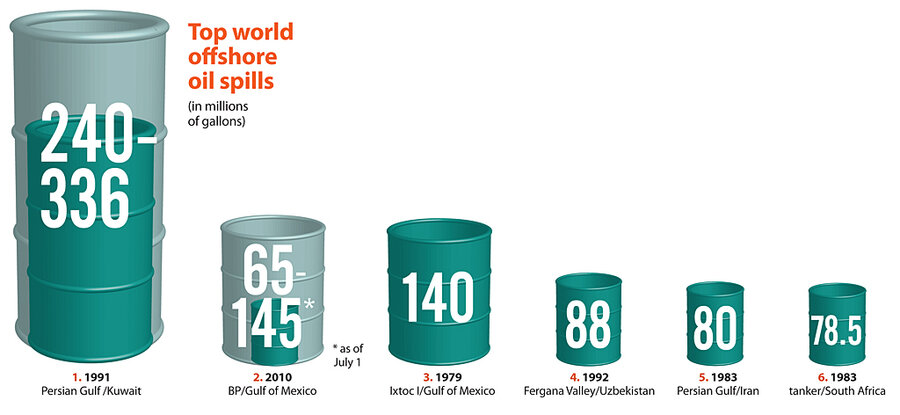Gulf oil spill saga: The rocky path from epic disaster to renewed drilling
Loading...
One year ago on Wednesday, the Deepwater Horizon oil rig about 40 miles off the coast of Louisiana exploded, unleashing a torrent of crude oil into the Gulf of Mexico that would eventually become the worst offshore spill during peacetime. This recounting of events tells how the initial estimates of the spill's size were soon eclipsed, how BP failed to contain the leak for months, and how now, the US has issued several new permits for deep-water drilling in the Gulf. Included are Monitor reports published as the events unfolded.
Week 1
April 20, 2010
An explosion on the Deepwater Horizon rig, 40 miles from shore, kills 11. The rig’s blowout preventer, a fail safe designed to stop oil flow in the event of an emergency, fails to do so. Coast Guard officials predict that as many as 8,000 barrels of oil could flow into the Gulf each day, an estimate that later turns out to be a lowball guess.
April 22
Deepwater Horizon sinks, putting out fires that had raged since the April 20 explosion. But this is a mixed blessing. The fire had been burning the oil, which now pours out into the Gulf and begins to wreak havoc on the coastal ecosystem.
April 26
BP deploys 15,000 gallons of dispersant, which are designed to break up oil before it reaches the shore, and 21,000 feet of containment boom, which repel water and soak up oil. These are the first of much more to come.
Next: A desperate search for a solution
April 28
A controlled burn of the oil begins in an attempt to remove it. It's an experimental solution, and seen by many as a last-ditch effort to stop the oil from reaching the coast.
May 2
As options run thin, BP begins drilling the first of two relief wells. Ocean engineer Prof. Jerome Milgram describes the wells as "a silver bullet" during an interview with the Monitor the next day.
May 5
BP caps one of three leaks, but oil flow is unabated as it continues to spew from the remaining two leaks.
May 8
A large containment dome fails to stop leaks.
May 20
Estimates of daily escaping oil rise from 5,000 barrels (210,000 gallons) to between 20,000 and 100,000 barrels.
May 26
So-called "top kill" pumps thousands of barrels of mud into well, but fails to stop leak. The failure of the top kill leads people to speculate what the next option would be.
May 28
President Obama declares a six-month moratorium on deep-water offshore drilling. The moratorium builds upon a previously announced 30-day halt to US-issued offshore drilling permits.
May 31
BP places a cap over the broken pipe, diverts 10,000 barrels a day from entering the Gulf.
Next: Success at last. Here's how.
July 15
Oil leak halted for first time, thanks to a tighter cap. Total estimated leakage: 4.9 million barrels, the worst spill in US history.
Sept. 19
After months of trying, and getting 300,000 ideas from around the world, BP permanently plugs the leak after sealing the well with a cement plug pumped in via a relief well.
Aftermath
Oct. 12
The deep-water offshore drilling moratorium is lifted. Federal regulators announce new measures they say will help prevent oil spills in the future and will require oil companies to be more prepared for a spill.
Feb. 28, 2011
The US grants the first permit for deep-water drilling since the spill. The permit goes to the Houston company Noble Energy Inc., which plans to continue work on a well it abandoned during the moratorium.







